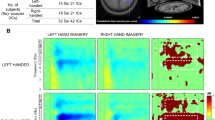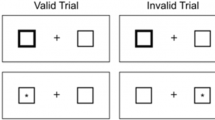Biocontrol based on fMRI signals from the motor area of the cortex is a potential approach to restoring motor functions in poststroke states and Parkinson’s disease. The region of interest in most studies is in the secondary motor areas and the strength of the magnetic field is 3 T. We report here our studies on biocontrol using the fMRI signal from an area of the primary motor cortex associated with the operation of the right hand obtained using a 1.5-T tomograph and settings optimal for obtaining optimal images at this magnetic field strength. Subjects were 16 healthy subjects who took part in 30-min fMRI recording including 1) individual localization of the region of interest (rhythmic fist clenching test) and attempts to control its activity using 2) imaginary movements and 3) any cognitive strategy of the participant’s choice. Attempts to carry out self-control in both cases led to activation of the precentral, anterior cingulate, superior frontal, and inferior parietal gyri and Brodmann zone 6. fMRI signal maps for these tasks did not show any statistically significant differences and the activation zones showed little if any overlap with the region of interest, evidencing lack of success of sessions. The limitations of the experiments are discussed, as are factors with adverse influences on the effectiveness of biocontrol.
Similar content being viewed by others
References
Berman, B. D., Horovitz, S. G., Venkataraman, G., and Hallett M., “Self-modulation of primary motor cortex activity with motor and motor imagery tasks using realtime fMRI-based neurofeedback,” Neuroimage, 59, 917–925 (2012).
Boldyreva, G. N., Sharova, E. V., Zhavoronkova, L. A., et al., “Structural-functional characteristics of brain operation on execution and imagination of motor loads in healthy people (EEG and fMRI investigations),” Zh. Vyssh. Nerv. Deyat., 63, 316–327 (2013).
Bruhl, A. B., “Making sense of real-time functional magnetic resonance imaging (rtfMRI) and rtfMRI neurofeedback,” Int. J. Neuropsychopharmacol., 18, 20 (2015).
Caldara, R., Deiber, M.-P., Andrey, C., et al., “Actual and mental motor preparation and execution: a spatiotemporal ERP study,” Exp. Brain Res., 159, 389–399 (2004).
Cavanna, A. E. and Trimble, M. R., “The precuneus: a review of its functional anatomy and behavioural correlates,” Brain, 129, No. 3, 564–583 (2006).
Culham, J. C., Cavina-Pratesi, C., and Singhal, A., “The role of parietal cortex in visuomotor control: What have we learned from neuroimaging?” Neuropsychologia, 44, 2668–2684 (2006).
Grefkes, C., Ritzl, A., Zilles, K., and Fink, G. R., “Human medial intraparietal cortex subserves visuomotor coordinate transformation,” NeuroImage, 23, 1494–1506 (2004).
Hampson, M., Scheinost, D., Qiu, M., et al., “Biofeedback of real-time functional magnetic resonance imaging data from the supplementary motor area reduces functional connectivity to subcortical regions,” Brain Connect., 1, 91–98 (2011).
Holper, L., Muehlemann, T., Scholkmann, F., et al., “Testing the potential of a virtual reality neurorehabilitation system during performance of observation, imagery and imitation of motor actions recorded by wireless functional nearinfrared spectroscopy (fNIRS),” J. Neuroeng. Rehabil., 7, 57 (2010).
Johnson, K. A., Hartwell, K., LeMatty, T., et al., “Intermittent ‘real-time’ fMRI feedback is superior to continuous presentation for a motor imagery task: a pilot study,” J. Neuroimaging, 22, 58–66 (2012).
Kim, S. and Birbaumer N., “Real-time functional MRI neurofeedback: a tool for psychiatry,” Curr. Opin. Psychiatry, 27, 332–336 (2014).
Mihara, M., Hattori, N., Hatakenaka, M., et al., “Near-infrared spectroscopy-mediated neurofeedback enhances efficacy of motor imagery-based training in poststroke victims,” Stroke, 44, 1091–1098 (2013).
Scharnowski, F., Veit, R., Zopf, R., et al., “Manipulating motor performance and memory through real-time fMRI neurofeedback,” Biol. Psychol., 108, 85–97 (2015).
Schuster, C., Hilfiker, R., Amfi, O., et al., “Best practice for motor imagery: a systematic literature review on motor imagery training elements in five different disciplines,” BMC Medicine, 9, 75 (2011).
Stoeckel, L. E., Garrison, K. A., Ghosh, S. S., et al., “Optimizing real time fMRI neurofeedback for therapeutic discovery and development,” Neuroimage Clin., 5, 245–255 (2014).
Subramanian, L., Hindle, J. V., Johnston, S., et al., “Real-time functional magnetic resonance imaging neurofeedback for treatment of Parkinson’s disease,” J. Neurosci., 31, 16,309–16,317 (2011).
Sulzer, J., Haller, S., Schamowski, F., et al., “Real-time fMRI neurofeedback: Progress and challenges,” NeuroImage, 76, 386–399 (2013).
Sun, L., Yin, D., Zhu, Y., et al., “Cortical reorganization after motor imagery training in chronic stroke patients with severe motor impairment: a longitudinal fMRI study,” Neuroradiology, 55, 913–925 (2013).
Talati, A. and Hirsch, J., “Functional specialization within the medial frontal gyrus for perceptual go/no-go decisions based on ‘what,’ ‘when,’ and “where” related information: an fMRI study,” J. Cogn. Neurosci., 17, 981–993 (2005).
Tanaka, S., Honda, M., and Sadato, N., “Modality-specific cognitive function of medial and lateral human Brodmann area 6,” J. Neurosci., 25, No. 2, 496–501 (2005).
Weiskopf, N., Mathiak, K., Bock, S. W., et al., “Principles of a brain-computer interface (BCI) based on real-time functional magnetic resonance imaging (fMRI),” IEEE Trans. Bio-Med. Eng., 51, 966–970 (2004).
Yoo, S. S., Lee, J. H., O’Leary, H., et al., “Neurofeedback fMRI mediated learning and consolidation of regional brain activation during motor imagery,” Int. J. Imag. Syst. Technol., 18, 69–78 (2008).
Author information
Authors and Affiliations
Corresponding author
Additional information
Translated from Zhurnal Vysshei Nervnoi Deyatel’nosti imeni I. P. Pavlova, Vol. 67, No. 1, pp. 83–92, January–February, 2017.
Rights and permissions
About this article
Cite this article
Mel’nikov, M.E., Savelov, A.A., Shtark, M.B. et al. Experience in Continuous Neurobiocontrol Using fMRI Signals from the Primary Motor Cortex Using a 1.5-T MR Tomograph. Neurosci Behav Physi 48, 474–482 (2018). https://doi.org/10.1007/s11055-018-0588-2
Received:
Accepted:
Published:
Issue Date:
DOI: https://doi.org/10.1007/s11055-018-0588-2




